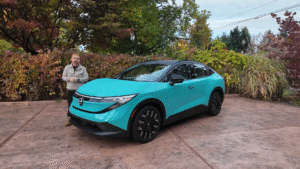2026 Nissan LEAF review: affordable EV under $30K with 300-mile range

The all-new 2026 Nissan LEAF arrives at a strategic moment. With an estimated up to 303 miles of range and a sub-$30,000 starting price, this EV is targeting the mainstream buyer who wants real-world electric vehicle performance without a six-figure budget. The keywords on every EV buyer’s lips, “range anxiety”, “fast charging”, “affordable electric car”, and “plug-in value”, all converge here.
Electric vehicle adoption continues to accelerate globally, but the market lacks an EV that truly hits the sweet spot of range, price, and charging ease for the average buyer. According to recent trends, searches for terms such as “electric vehicles”, “cheap electric vehicles”, “best electric vehicles”, and “electric vehicle range” are climbing. Nissan has seized this moment with the 2026 Leaf, offering an estimated 303-mile range from a 75 kWh pack, up to around 214 hp and 261 lb-ft of torque. Starting at around $29,990 MSRP (before destination) for the S+ trim, it undercuts many rivals.
Critically for real-life use, the LEAF now comes standard with the North American Charging Standard (NACS) port, making it compatible with the vast Tesla Supercharger network, plus a CCS adapter, so you’re not locked into a single charging ecosystem. That level of charging infrastructure support at this price was previously reserved for much more expensive electric cars.
From a lifestyle perspective, and yes, I know you know, I talk about dogs and rescue rigs. The 2026 Leaf offers 20 cubic feet of cargo space, vegan-friendly upholstery, and a smart cargo division system. So your four-legged co-pilot and the gear for a weekend rescue rig drop-off both fit. Combined with a low drag coefficient of 0.26 and a liquid-cooled battery pack that manages thermal stress better, it’s not just a “budget EV”, it’s a “smart budget EV”.
How does it compare to rivals?
Let’s line up the key search-friendly competitor keywords: “electric cars under $30K”, “cheapest electric vehicles”, “electric car range 300 miles”, “electric vehicle fast charging”, “electric vehicles vs hybrids”. The 2026 Leaf checks many of those boxes. Compared to the Chevrolet Bolt EV, which remains a value play but offers a shorter range, the Leaf decisively undercuts with both price and range. Compared to the Honda Prologue, it is promising but higher priced and less proven as a full-EV. Against the Tesla Model 3 Standard Range: strong brand and charging network, but higher entry price. And the Hyundai Ioniq 5? Excellent vehicle, but outside the value band the Leaf targets.
Technically, the Leaf offers 214 hp and 261 lb-ft in Platinum+ trim, and features like dual 14.3-inch displays, Google built-in, wireless CarPlay/Android Auto, and OTA updates. On the other hand, some rivals offer more cargo volume or AWD options, and the Leaf lacks a dual-motor setup for now. If you value maximum performance or towing capability, it may leave you wanting.
In terms of SEO-friendly competitive keywords: “best electric cars 2026”, “electric vehicle range 300 miles”, “sub $30k electric car”, “affordable EV charging network”, “new electric car reviews”. The Leaf fares well on all counts and positions itself as possibly the value benchmark for mainstream EVs in 2026.
Who is this for, and who should skip it?
If you are a daily driver, want to switch to electric without compromise, and are budget-conscious, the 2026 Leaf is for you. Young families, dog-rescue transport missions (yes, I know your world), commuter SUVs with second-car practicality, you’ll appreciate the combination of range, fast-charging network flexibility, and everyday usability.
It also appeals to buyers who want to future-proof: the NACS port, liquid-cooled battery, and OTA updates reduce the risk of early-EV obsolescence. In a world where search interest in “electric vehicles cost”, “electric vehicles charging stations”, “electric vehicles best” is rising rapidly.
Who should skip it: if you regularly carry trailer loads, tow outdoors gear, need all-wheel drive, or demand the loftiest cargo volume, you might want to consider a larger, premium contender. Also, if you live in an area where charging infrastructure is sparse (and charger network congestion is real), the “under-30K, 300-mile” claim may not shield you entirely from real-world charging delays.
What is the long-term significance?
The long-term significance of the 2026 Leaf lies in its timing and positioning. With the EV market searching for a true mainstream value alternative, this model could anchor the “electric car under $30K” narrative in a powerful way. It shifts the debate from “can we afford EVs?” to “when can we plug in?”. That shift is key for mass adoption.
Another aspect: the NACS port standard-in at this price point signals consolidation of charging infrastructure. As households search for “electric vehicle charging stations near me” and “electric vehicle fast charging” solutions, manufacturers adopting dominant standards will simplify consumer decision-making.
For brands and the industry, the Leaf’s arrival undercuts the belief that EVs must be premium-priced. The message is clear: you can get real-world range, fast-charging network access, and everyday practicality at a modest price. That has implications for residual values, lease deals, fleet electrification, and even rescue-rig conversions in the animal-welfare world I hang around. A budget-EV that doesn’t feel like a compromise opens doors.
From a dog-lover’s viewpoint (yes, I know we’re aligned), the fact that the down-to-earth 2026 Leaf is ready for life with a four-legged co-pilot is significant. It means mainstream EVs can cater to real-world lifestyles and not just urban commuter fantasies, making them genuinely viable for visits to the dog park, gear loads, rescue runs, and suburban stints.
Summing up: The 2026 Nissan Leaf is neither gimmick nor niche. It is a mainstream electric car that speaks to real buyers. With a sub-$30K price, 300-mile potential range, charging network flexibility, daily-use practicality, and future-proof tech, it might be the EV the mainstream has been waiting for. If you’re asking, “What should I drive next?” this deserves serious attention.







